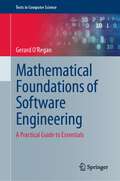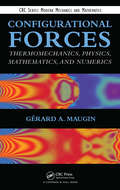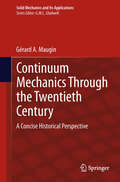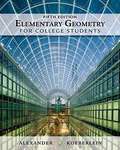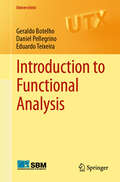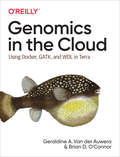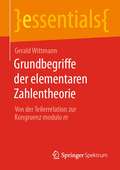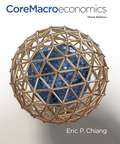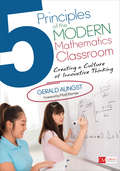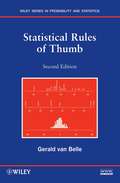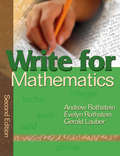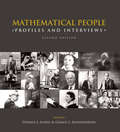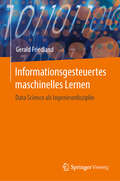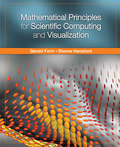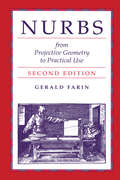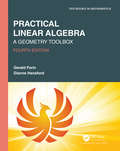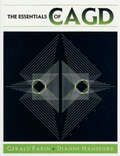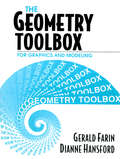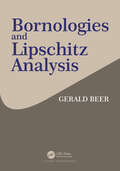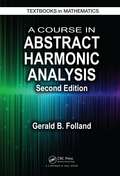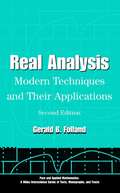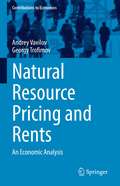- Table View
- List View
Mathematical Foundations of Software Engineering: A Practical Guide to Essentials (Texts in Computer Science)
by Gerard O'ReganThis textbook presents an introduction to the mathematical foundations of software engineering. It presents the rich applications of mathematics in areas such as error-correcting codes, cryptography, the safety and security critical fields, the banking and insurance fields, as well as traditional engineering applications. Topics and features: Addresses core mathematics for critical thinking and problem solving Discusses propositional and predicate logic and various proof techniques to demonstrate the correctness of a logical argument. Examines number theory and its applications to cryptography Considers the underlying mathematics of error-correcting codes Discusses graph theory and its applications to modelling networks Reviews tools to support software engineering mathematics, including automated and interactive theorem provers and model checking Discusses financial software engineering, including simple and compound interest, probability and statistics, and operations research Discusses software reliability and dependability and explains formal methods used to derive a program from its specification Discusses calculus, matrices, vectors, complex numbers, and quaternions, as well as applications to graphics and robotics Includes key learning topics, summaries, and review questions in each chapter, together with a useful glossary This practical and easy-to-follow textbook/reference is ideal for computer science students seeking to learn how mathematics can assist them in building high-quality and reliable software on time and on budget. The text also serves as an excellent self-study primer for software engineers, quality professionals, and software managers.
Configurational Forces: Thermomechanics, Physics, Mathematics, and Numerics (Modern Mechanics and Mathematics)
by Gerard A. MauginExploring recent developments in continuum mechanics, Configurational Forces: Thermomechanics, Physics, Mathematics, and Numerics presents the general framework for configurational forces. It also covers a range of applications in engineering and condensed matter physics. The author presents the fundamentals of accepted standard continuum mechanics
Continuum Mechanics Through the Twentieth Century: A Concise Historical Perspective (Solid Mechanics and Its Applications #196)
by Gerard A MauginThis overview of the development of continuum mechanics throughout the twentieth century is unique and ambitious. Utilizing a historical perspective, it combines an exposition on the technical progress made in the field and a marked interest in the role played by remarkable individuals and scientific schools and institutions on a rapidly evolving social background. It underlines the newly raised technical questions and their answers, and the ongoing reflections on the bases of continuum mechanics associated, or in competition, with other branches of the physical sciences, including thermodynamics. The emphasis is placed on the development of a more realistic modeling of deformable solids and the exploitation of new mathematical tools. The book presents a balanced appraisal of advances made in various parts of the world. The author contributes his technical expertise, personal recollections, and international experience to this general overview, which is very informative albeit concise.
Elementary Geometry for College Students
by Daniel C. Alexander Geralyn M. KoeberleinBuilding on the success of its first four editions, the Fifth Edition of this market-leading text covers the important principles and real-world applications of plane geometry, with a new chapter on locus and concurrence and by adding 150-200 new problems including 90 designed to be more rigorous. Strongly influenced by both NCTM and AMATYC standards, the text takes an inductive approach that includes integrated activities and tools to promote hands-on application and discovery.
Introduction to Functional Analysis (Universitext)
by Geraldo Botelho Daniel Pellegrino Eduardo TeixeiraThis textbook offers an accessible introduction to Functional Analysis, providing a solid foundation for students new to the field. It is designed to support learners with no prior background in the subject and serves as an effective guide for introductory courses, suitable for students in mathematics and other STEM disciplines. The book provides a comprehensive introduction to the essential topics of Functional Analysis across the first seven chapters, with a particular emphasis on normed vector spaces, Banach spaces, and continuous linear operators. It examines the parallels and distinctions between Functional Analysis and Linear Algebra, highlighting the crucial role of continuity in infinite-dimensional spaces and its implications for complex mathematical problems. Later chapters broaden the scope, including advanced topics such as topological vector spaces, techniques in Nonlinear Analysis, and key theorems in theory of Banach spaces. Exercises throughout the book reinforce understanding and allow readers to test their grasp of the material. Designed for students in mathematics and other STEM disciplines, as well as researchers seeking a thorough introduction to Functional Analysis, this book takes a clear and accessible approach. Prerequisites include a strong foundation in analysis in the real line, linear algebra, and basic topology, with helpful references provided for additional consultation.
Genomics in the Cloud: Using Docker, GATK, and WDL in Terra
by Geraldine A. Van der Auwera Brian D. O'ConnorData in the genomics field is booming. In just a few years, organizations such as the National Institutes of Health (NIH) will host 50+ petabytesâ??or over 50 million gigabytesâ??of genomic data, and theyâ??re turning to cloud infrastructure to make that data available to the research community. How do you adapt analysis tools and protocols to access and analyze that volume of data in the cloud?With this practical book, researchers will learn how to work with genomics algorithms using open source tools including the Genome Analysis Toolkit (GATK), Docker, WDL, and Terra. Geraldine Van der Auwera, longtime custodian of the GATK user community, and Brian Oâ??Connor of the UC Santa Cruz Genomics Institute, guide you through the process. Youâ??ll learn by working with real data and genomics algorithms from the field.This book covers:Essential genomics and computing technology backgroundBasic cloud computing operationsGetting started with GATK, plus three major GATK Best Practices pipelinesAutomating analysis with scripted workflows using WDL and CromwellScaling up workflow execution in the cloud, including parallelization and cost optimizationInteractive analysis in the cloud using Jupyter notebooksSecure collaboration and computational reproducibility using Terra
Grundbegriffe der elementaren Zahlentheorie: Von der Teilerrelation zur Kongruenz modulo m (essentials)
by Gerald WittmannDie elementare Zahlentheorie befasst sich mit den Eigenschaften der natürlichen Zahlen und benötigt als Grundlage hierfür nur die Arithmetik. Sie ist ein unverzichtbarer Bestandteil des Bachelorstudiums Mathematik.Die Leser*innen erhalten mit diesem essential eine kompakte und auf das Wesentliche fokussierte Darstellung der elementaren Zahlentheorie, die insbesondere für einen ersten Überblick über dieses Teilgebiet, für die Prüfungsvorbereitung oder zum Nachschlagen wichtiger Definitionen und Sätze herangezogen werden kann.
Core Macroeconomics (3rd Edition)
by Eric P. Chiang Gerald W. StoneWith this new edition, Eric Chiang transforms CoreMacroeconomics into a text/media resource well attuned to today’s students. Long active in the economics education community, Chiang brings a contemporary teacher’s perspective to the book, supporting a variety of learning approaches by introducing modern topics, new pedagogy, a more visual presentation, and well-integrated media tools. All this while maintaining the book’s defining focus on just those topics instructors cover most often in the course.
5 Principles of the Modern Mathematics Classroom: Creating a Culture of Innovative Thinking (Corwin Mathematics Series)
by Gerald W. AungstStudents pursue problems they’re curious about, not problems they’re told to solve. Creating a math classroom filled with confident problem solvers starts by introducing challenges discovered in the real world, not by presenting a sequence of prescribed problems, says Gerald Aungst. In this groundbreaking book, he offers a thoughtful approach for instilling a culture of learning in your classroom through five powerful, yet straightforward principles: Conjecture, Collaboration, Communication, Chaos, and Celebration. Aungst shows you how to Embrace collaboration and purposeful chaos to help students engage in productive struggle, using non-routine and unsolved problems Put each chapter’s principles into practice through a variety of strategies, activities, and by incorporating technology tools Introduce substantive, lasting cultural changes in your classroom through a manageable, gradual shift in processes and behaviors Five Principles of the Modern Mathematics Classroom offers new ideas for inspiring math students by building a more engaging and collaborative learning environment. "Bravo! This book brings a conceptual framework for K-12 mathematics to life. As a parent and as the executive director of Edutopia, I commend Aungst for sharing his 5 principles. This is a perfect blend of inspiring and practical. Highly recommended!" Cindy Johanson, Executive Director, Edutopia George Lucas Educational Foundation "Aungst ignites the magic of mathematics by reminding us what makes mathematicians so passionate about their subject matter. Grounded in research, his work takes us on a journey into classrooms so that we may take away tips to put into practice today." Erin Klein, Teacher, Speaker, and Author of Redesigning Learning Spaces
5 Principles of the Modern Mathematics Classroom: Creating a Culture of Innovative Thinking (Corwin Mathematics Series)
by Gerald W. AungstStudents pursue problems they’re curious about, not problems they’re told to solve. Creating a math classroom filled with confident problem solvers starts by introducing challenges discovered in the real world, not by presenting a sequence of prescribed problems, says Gerald Aungst. In this groundbreaking book, he offers a thoughtful approach for instilling a culture of learning in your classroom through five powerful, yet straightforward principles: Conjecture, Collaboration, Communication, Chaos, and Celebration. Aungst shows you how to Embrace collaboration and purposeful chaos to help students engage in productive struggle, using non-routine and unsolved problems Put each chapter’s principles into practice through a variety of strategies, activities, and by incorporating technology tools Introduce substantive, lasting cultural changes in your classroom through a manageable, gradual shift in processes and behaviors Five Principles of the Modern Mathematics Classroom offers new ideas for inspiring math students by building a more engaging and collaborative learning environment. "Bravo! This book brings a conceptual framework for K-12 mathematics to life. As a parent and as the executive director of Edutopia, I commend Aungst for sharing his 5 principles. This is a perfect blend of inspiring and practical. Highly recommended!" Cindy Johanson, Executive Director, Edutopia George Lucas Educational Foundation "Aungst ignites the magic of mathematics by reminding us what makes mathematicians so passionate about their subject matter. Grounded in research, his work takes us on a journey into classrooms so that we may take away tips to put into practice today." Erin Klein, Teacher, Speaker, and Author of Redesigning Learning Spaces
Statistical Rules of Thumb
by Gerald Van BelleSensibly organized for quick reference, Statistical Rules of Thumb, Second Edition compiles simple rules that are widely applicable, robust, and elegant, and each captures key statistical concepts. This unique guide to the use of statistics for designing, conducting, and analyzing research studies illustrates real-world statistical applications through examples from fields such as public health and environmental studies. Along with an insightful discussion of the reasoning behind every technique, this easy-to-use handbook also conveys the various possibilities statisticians must think of when designing and conducting a study or analyzing its data.Each chapter presents clearly defined rules related to inference, covariation, experimental design, consultation, and data representation, and each rule is organized and discussed under five succinct headings: introduction; statement and illustration of the rule; the derivation of the rule; a concluding discussion; and exploration of the concept's extensions. The author also introduces new rules of thumb for topics such as sample size for ratio analysis, absolute and relative risk, ANCOVA cautions, and dichotomization of continuous variables. Additional features of the Second Edition include:Additional rules on Bayesian topicsNew chapters on observational studies and Evidence-Based Medicine (EBM)Additional emphasis on variation and causationUpdated material with new references, examples, and sourcesA related Web site provides a rich learning environment and contains additional rules, presentations by the author, and a message board where readers can share their own strategies and discoveries. Statistical Rules of Thumb, Second Edition is an ideal supplementary book for courses in experimental design and survey research methods at the upper-undergraduate and graduate levels. It also serves as an indispensable reference for statisticians, researchers, consultants, and scientists who would like to develop an understanding of the statistical foundations of their research efforts.A related website www.vanbelle.org provides additional rules, author presentations and more.
Write for Mathematics
by Andrew S. Rothstein Evelyn B. Rothstein Gerald LauberAddressing NCTM standards, this second edition offers a wide range of practical writing strategies to help students deepen their understanding of mathematical concepts and theories.
Mathematical People: Profiles and Interviews
by Gerald L. Alexanderson Donald AlbersThis unique collection contains extensive and in-depth interviews with mathematicians who have shaped the field of mathematics in the twentieth century. Collected by two mathematicians respected in the community for their skill in communicating mathematical topics to a broader audience, the book is also rich with photographs and includes an introdu
Informationsgesteuertes maschinelles Lernen: Data Science als Ingenieurdisziplin
by Gerald FriedlandDieses innovative Lehrbuch revolutioniert das maschinelle Lernen durch neue Informationsmessungsmethoden. Es basiert auf einem Seminar der UC Berkeley und zielt darauf ab, die Black-Box-Natur des maschinellen Lernens zu überwinden, indem es Datenqualitätsmessungen und A-priori-Schätzungen der Aufgabenkomplexität ermöglicht. Dies führt zu kleineren, erklärbareren und robusteren Modellen.Das Lehrbuch verbindet maschinelles Lernen mit Physik, Informationstheorie und Computertechnik und ist für ein breites Publikum verständlich. Es hinterfragt bestehende Branchenpraktiken und behandelt Themen wie Deep Learning und Datendrift. Geeignet für Akademiker und Industrieprofis, fördert es ein tiefgreifendes Verständnis von Data Science und lädt Leser ein, über konventionelle Ansätze hinauszudenken. Anstatt sich ausschließlich auf das „Wie“ zu konzentrieren, bietet dieser Text Antworten auf die „Warum“-Fragen, die das Fachgebiet durchdringen, und beleuchtet die zugrunde liegenden Prinzipien maschineller Lernprozesse und ihre praktischen Auswirkungen. Indem dieses Buch systematische Methoden bevorzugt, die auf physikalischen Grundprinzipien basieren, stellt es Branchenpraktiken in Frage, die oft aus ideologischen oder gewinnorientierten Motivationen entstanden sind. Es behandelt eine Reihe von Themen, darunter Deep Learning, Datendrift und MLOps, und nutzt ausgiebig grundlegende Konzepte wie Entropie, Kapazität und hohe Dimensionalität.Dieses Buch ist sowohl für Hochschul- als auch für Industrieprofis geeignet und dient als wertvolles Werkzeug für diejenigen, die ihr Verständnis von Data Science als Ingenieurdisziplin vertiefen möchten. Der zum Nachdenken anregende Inhalt regt die intellektuelle Neugier an und richtet sich an Leser, die mehr wollen als nur Code oder vorgefertigte Formeln. Der Text lädt die Leser dazu ein, über konventionelle Standpunkte hinauszuforschen und bietet eine alternative Perspektive, die eine umfassende Sichtweise für die Integration von Theorie und Praxis fördert. Dieses Buch eignet sich für Kurse im Grund- und Hauptstudium und kann auch praktizierenden Ingenieuren und Wissenschaftlern verschiedener Disziplinen zugute kommen, indem es ihr Verständnis der Modellierung vertieft und die Datenmessung effektiv verbessert.
Mathematical Principles for Scientific Computing and Visualization
by Gerald Farin Dianne HansfordThis non-traditional introduction to the mathematics of scientific computation describes the principles behind the major methods, from statistics, applied mathematics, scientific visualization, and elsewhere, in a way that is accessible to a large part of the scientific community. Introductory material includes computational basics, a review of coo
NURBS for Curve & Surface Design: From Projective Geometry to Practical Use
by Gerald FarinNon-Uniform Rational B-Splines have become the de facto standard in CAD/CAM and computer graphics. This well-known book covers NURBS from their geometric beginnings to their industrial applications. The second edition incorporates new results and a chapter on Pythagorean curves, a development that shows promise in applications such as NC machining
Practical Linear Algebra: A Geometry Toolbox (Textbooks in Mathematics)
by Gerald Farin Dianne HansfordLinear algebra is growing in importance. 3D entertainment, animations in movies and video games are developed using linear algebra. Animated characters are generated using equations straight out of this book. Linear algebra is used to extract knowledge from the massive amounts of data generated from modern technology. The Fourth Edition of this popular text introduces linear algebra in a comprehensive, geometric, and algorithmic way. The authors start with the fundamentals in 2D and 3D, then move on to higher dimensions, expanding on the fundamentals and introducing new topics, which are necessary for many real-life applications and the development of abstract thought. Applications are introduced to motivate topics. The subtitle, A Geometry Toolbox, hints at the book’s geometric approach, which is supported by many sketches and figures. Furthermore, the book covers applications of triangles, polygons, conics, and curves. Examples demonstrate each topic in action. This practical approach to a linear algebra course, whether through classroom instruction or self-study, is unique to this book. New to the Fourth Edition: Ten new application sections. A new section on change of basis. This concept now appears in several places. Chapters 14-16 on higher dimensions are notably revised. A deeper look at polynomials in the gallery of spaces. Introduces the QR decomposition and its relevance to least squares. Similarity and diagonalization are given more attention, as are eigenfunctions. A longer thread on least squares, running from orthogonal projections to a solution via SVD and the pseudoinverse. More applications for PCA have been added. More examples, exercises, and more on the kernel and general linear spaces. A list of applications has been added in Appendix A. The book gives instructors the option of tailoring the course for the primary interests of their students: mathematics, engineering, science, computer graphics, and geometric modeling.
The Essentials of CAGD
by Gerald Farin Dianne HansfordPutting the G into CAGD, the authors provide a much-needed practical and basic introduction to computer-aided geometric design. This book will help readers understand and use the elements of computer-aided geometric design, curves and surfaces, without the mathematical baggage that is necessary only for more advanced work. Though only minimal backg
The Geometry Toolbox for Graphics and Modeling
by Gerald Farin Dianne HansfordThe Geometry Toolbox takes a novel and particularly visual approach to teaching the basic concepts of two- and three-dimensional geometry. It explains the geometry essential for today's computer modeling, computer graphics, and animation systems. While the basic theory is completely covered, the emphasis of the book is not on abstract proofs but rather on examples and algorithms. The Geometry Toolbox is the ideal text for professionals who want to get acquainted with the latest geometric tools. The chapters on basic curves and surfaces form an ideal stepping stone into the world of graphics and modeling. It is also a unique textbook for a modern introduction to linear algebra and matrix theory.
Bornologies and Lipschitz Analysis
by Gerald BeerThis monograph, for the first time in book form, considers the large structure of metric spaces as captured by bornologies: families of subsets that contain the singletons, that are stable under finite unions, and that are stable under taking subsets of its members. The largest bornology is the power set of the space and the smallest is the bornology of its finite subsets. Between these lie (among others) the metrically bounded subsets, the relatively compact subsets, the totally bounded subsets, and the Bourbaki bounded subsets. Classes of functions are intimately connected to various bornologies; e.g., (1) a function is locally Lipschitz if and only if its restriction to each relatively compact subset is Lipschitz; (2) a subset is Bourbaki bounded if and only if each uniformly continuous function on the space is bounded when restricted to the subset. A great deal of attention is given to the variational notions of strong uniform continuity and strong uniform convergence with respect to the members of a bornology, leading to the bornology of UC-subsets and UC-spaces. Spaces on which its uniformly continuous real-valued functions are stable under pointwise product are characterized in terms of the coincidence of the Bourbaki bounded subsets with a usually larger bornology. Special attention is given to Lipschitz and locally Lipschitz functions. For example, uniformly dense subclasses of locally Lipschitz functions within the real-valued continuous functions, Cauchy continuous functions, and uniformly continuous functions are presented. It is shown very generally that a function between metric spaces has a particular metric property if and only if whenever it is followed in a composition by a real-valued Lipschitz function, the composition has the property. Bornological convergence of nets of closed subsets, having Attouch-Wets convergence as a prototype, is considered in detail. Topologies of uniform convergence for continuous linear operators between normed spaces is explained in terms of the bornological convergence of their graphs. Finally, the idea of a bornological extension of a topological space is presented, and all regular extensions can be so realized.
A Course in Abstract Harmonic Analysis (Textbooks in Mathematics)
by Gerald B. FollandA Course in Abstract Harmonic Analysis is an introduction to that part of analysis on locally compact groups that can be done with minimal assumptions on the nature of the group. As a generalization of classical Fourier analysis, this abstract theory creates a foundation for a great deal of modern analysis, and it contains a number of elegant resul
Real Analysis
by Gerald B. FollandAn in-depth look at real analysis and its applications-now expanded and revised. This new edition of the widely used analysis book continues to cover real analysis in greater detail and at a more advanced level than most books on the subject. Encompassing several subjects that underlie much of modern analysis, the book focuses on measure and integration theory, point set topology, and the basics of functional analysis. It illustrates the use of the general theories and introduces readers to other branches of analysis such as Fourier analysis, distribution theory, and probability theory. This edition is bolstered in content as well as in scope-extending its usefulness to students outside of pure analysis as well as those interested in dynamical systems. The numerous exercises, extensive bibliography, and review chapter on sets and metric spaces make Real Analysis: Modern Techniques and Their Applications, Second Edition invaluable for students in graduate-level analysis courses. New features include: * Revised material on the n-dimensional Lebesgue integral. * An improved proof of Tychonoff's theorem. * Expanded material on Fourier analysis. * A newly written chapter devoted to distributions and differential equations. * Updated material on Hausdorff dimension and fractal dimension.
Everyday Chemicals: Understanding the Risks
by Gerald A. LeBlancWhat is the likelihood that common chemicals such as bisphenol-A, which is found in plastic water bottles, are harming us? Should shoppers be concerned about pesticide residues on fruits and vegetables in the supermarket produce aisle? Are we risking adverse health effects when we use insect repellent that contains DEET or slather on sunscreen? Modern life requires us to navigate an endless sea of chemicals. How do we know whether we need to worry about them?This book is a layperson’s guide to understanding chemical risk. The toxicologist Gerald A. LeBlanc offers a nontechnical overview of the key factors in evaluating whether exposure to chemicals in our daily lives could be harmful. He leads readers through the basic concepts of risk assessment using real-world examples. LeBlanc emphasizes that chemical hazard depends on the level of exposure and provides practical strategies for sensible decision making. The book features a series of accessible case studies describing how we all can reach rational conclusions about the danger of typical chemical exposures we experience every day.Giving nonexpert readers the tools to understand chemical risks, this book shows how critical thinking and science literacy can help us live with less fear and anxiety and make reasonable choices when confronted with potential hazards.
Natural Resource Pricing and Rents: An Economic Analysis (Contributions to Economics)
by Andrey Vavilov Georgy TrofimovThis book examines the economics of natural resource markets and pricing, as well as the field of natural resource economics in general. It presents the key contributions to this field of research, including the pioneering works and contemporary studies. The book highlights the basic principles and ideas underlying theoretical models of resource pricing. The models considered in the book underline the fundamental determinants of resource prices and the economic nature of rents for non-renewable and renewable resources. Besides the classical theory of exhaustible resource economics, the book includes several issues that are of high importance for global economic growth, such as the transition to alternative energy and the economics of climate change. The authors also consider the issues of commodity pricing and a resource cartel’s activity that are relevant to the world oil market.The book provides analytical solutions illustrated with numerical examples. It allows an intuitive understanding of the subject and the model inferences through graphical illustrations and an informal introduction. It, therefore, is a must-read for everybody interested in a better understanding of resource prices, resource markets, and resource economics.
The Stochastic Nature of Environmental Phenomena and Processes
by Costas Varotsos Georgy GolitsynThis book is useful not only for young but also for mature scientists who are preparing methods for studying natural environmental phenomena and their alteration by human activity. As spatio-temporal scales of natural environmental phenomena become larger, the variance of their fluctuations increases or decreases over wide ranges. Such signals appear not only in environmental dynamics but everywhere, even in seemingly unrelated fields. When one looks at these signals more closely, one finds that they are governed by specific, measurable scaling laws, that is, a statistical relationship between big and small, between fast and slow. In this book, the authors describe and explain processes that have puzzled environmental science for decades, such as the climate crisis, clouds, turbulence, earthquakes, cosmic rays, sea wind waves, hurricanes, floods, radiation field in the climate system, ozone hole, greenhouse effect, air pollution, El Nino / La Nina, nowcasting models.
